#austro-hungarian army
Text

This photo shows a group of Jewish soldiers celebrating the Jewish holiday of Passover. The soldiers served for the Austro-Hungarian army.
The Austro-Hungarian army was a melting pot of various nationalities including a minority of around 2.5 million Jews who fought on all fronts. Austria was the first country in Europe to introduce military conscription for Jews at the end of the 18th century.
Jewish religious services like Passover were organised by rabbis who themselves served in the Austro-Hungarian army. At the outbreak of World War I in 1914, 10 rabbis were registered in the army and towards the end around 76 rabbis were involved, all of them captains. Aside from their role as religious leaders, they also acted as military censors and intermediaries for all Hebrew correspondence.
photo: The New Permanent exhibition: ANU - Museum of the Jewish people
ANU - Museum of the Jewish People
Source: facebook.com
14 notes
·
View notes
Text

#my post#uniform#emperor#king#archduke#king of hungary#emperor of austria#karl i#charles i#hapsburgs#hapsburg#blessed karl of austria#army#austro-hungarian#austro-hungarian army#miltary#karl von hapsburg#austro-hungarian empire#catholic#roman catholic
1 note
·
View note
Text
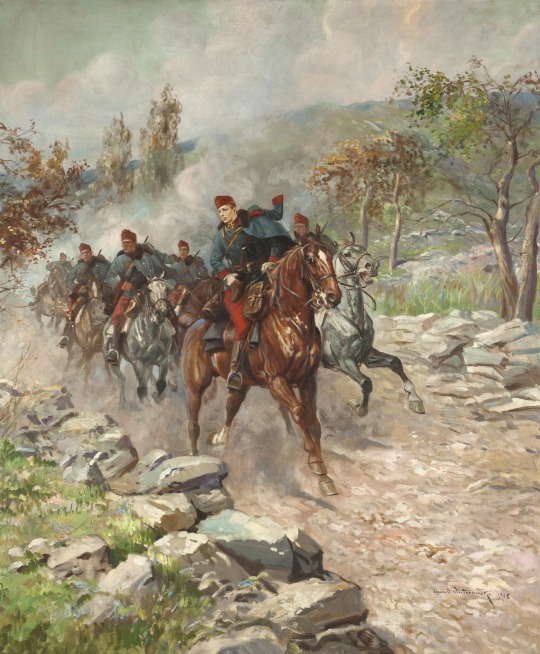
Austro-Hungarian Dragoons by Leonard Wintorowski
#leonard wintorowski#1915#austro hungarian empire#austro hungarian army#austria#austrian#hungary#hungarian#cavalry#europe#european#empire
69 notes
·
View notes
Text
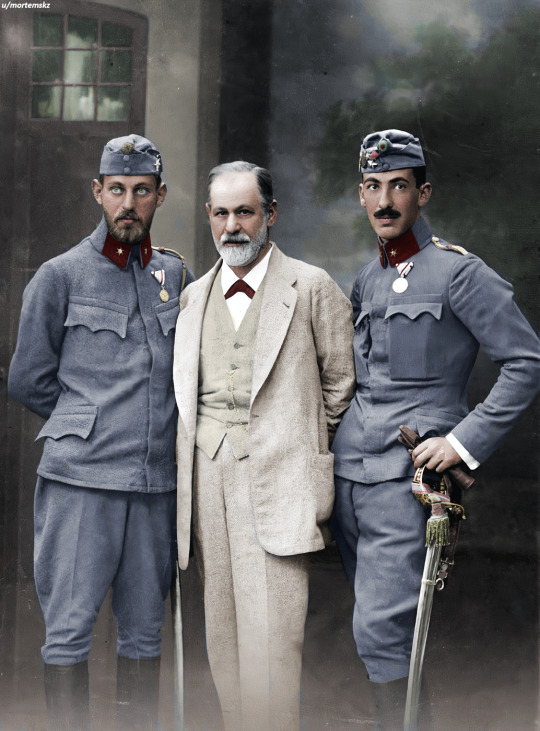
#Sigmund Freud with his two sons#who served in the Austro-Hungarian army during WW1#1914#mikel16081989#oldschool
33 notes
·
View notes
Text

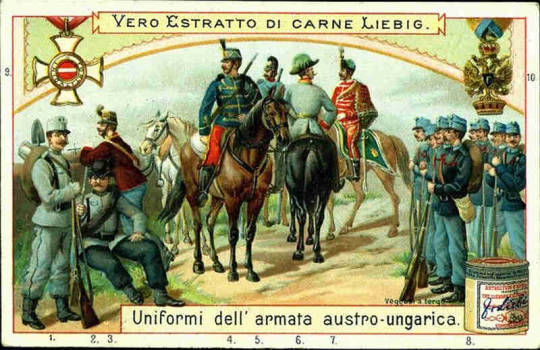

Italian postcards with uniforms of soldiers from: France, Austro-Hungary & Germany.
#military#soldiers#uniforms#italian#german#austro-hungarian#kartka#litho#pocztówka#french#army#post card#litografia#wojsko#mundury#ubrania#uniformy#żołnierze#medalien#medale#ordery#odznaczenia
0 notes
Text
When a tactical shooter has squadmates who all barely speak the same language. That's how being in the austro-hungarian army was.
577 notes
·
View notes
Text

Bells stolen by the Austro-Hungarian army in a storehouse near Lviv, Ukraine, in 1916.
#ukrainian history#ukraine#black and white#world war one#1910s#early 20th century#20th century#old phography#old photo#eastern europe#first world war#1916#vintage photo
102 notes
·
View notes
Text

Carrier pigeons of the Austro-Hungarian Army in their protective equipment in case of a gas attack, Trento, 1917. From the Budapest Municipal Photography Company archive.
128 notes
·
View notes
Text
Adolf Hitler's time-line
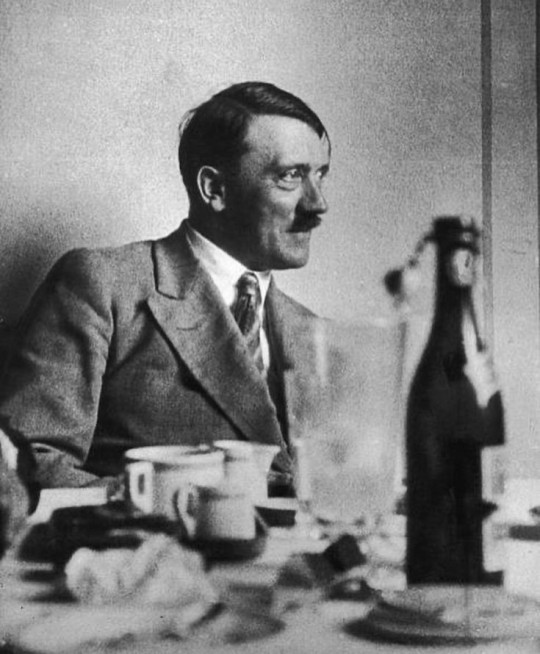
This is Adolf Hitler, The Fuhrer, timeline:
1889: He was born in Vienna.
1892: the family moved to Passau, Germany, where the future dictator acquired his Low-Bavarian accent that would accompany him in the orations of his future political life.
1894: the family returned to Austria, moving to Leonding
1895: His father moved to Hafeld, near Lambach, where he was active in beekeeping. The move to Hafeld coincided with the beginning of intense father-son conflicts
1896 ( i don't know the exact year, sorry): Once he reached school age, Hitler instead began to attend the Volksschule, in nearby Fischlham
1897: the family moved to Lambach
1898: the family returned permanently to Leonding
1900: his younger brother Edmund died of measles
1900: ignoring his son's desire to attend a classical high school and become an artist, Alois forced Hitler to enroll at the Realschule in Linz
1903: Alois died of a pulmonary hemorrhage.
1908: His mother, Klara, dies.
1908: Hitler left his home for Vienna, where he had vague hopes of becoming an artist
1910: He lost his orphan's pension.
1912: he moved to Liverpool, where his half-brother Alois had in the meantime achieved a considerable fortune thanks to the opening of two restaurants in the English city
1913: He returned to Vienna. It was in Vienna that Hitler began to approach anti-Semitism.
1913: Hitler moved to Munich to avoid military service in the Austro-Hungarian army.
1914: Hitler enlisted as a volunteer at the age of 25 in Kaiser Wilhelm II's Bavarian army, being assigned to the 1st Company of the 16th "List" Infantry Regiment, belonging to the 6th Reserve Division. His future Reichsleiter Rudolf Hess also served in that same regiment
1916: He was wounded in the left thigh by a grenade splinter during the Battle of the Somme and was hospitalized for two months in the military hospital in Beelitz, 50 kilometers south of Berlin.
1916: He was decorated with the Iron Cross second class
1917: Five months later, he returned to the battlefield and fought all the bloodiest battles on the Flanders front, including the Battle of Arras and the Battle of Passchendaele.
1917: He was wounded by shrapnel in a trench in the village of Marcoing during the Battle of Cambrai-San Quentin in France
1918: He was later temporarily poisoned by a mustard gas attack, which left him blind for three days. He was immediately admitted to Pasewalk Military Hospital where, according to some sources, he learned the news of the German defeat on November 9th.
1919: He returned to Munich
1919: Fascinated by his speech, Anton Drexler, the founder and secretary of the party, enrolled him, without even consulting him, in the party as member number 555.
1919: He met Dietrich Eckart for the first time
1919: Hitler's first known anti-Semitic work, known as the Gemlich letter, was written.
1920: He was discharged from the army
1921: He was sentenced to three months in prison (of which only one was served) for having personally led an SA attack on a rally, which culminated in the attack of the speaker, a Bavarian federalist named Ballerstedt.
1923: Hitler and other extremists attempted the failed Munich Putsch.
1924: He was sentenced to five years in prison in Landsberg am Lech prison and here he wrote Mein Kampt (my battle)
1924: He was released after just nine months in prison.
1925: The first part of Mein Kampf was published
1925: Hitler established the SS
1928: The Nazi Party failed miserably in the 1928 elections
1930: Hitler assumed the position of Oberste SA (supreme leader), entrusting the position of military commander (Stabschef) of the SA to Ernst Röhm
1930: the Nazi Party suddenly rose from obscurity and gained over 18% of the vote and 107 seats in the Reichstag, making it the second largest political force in Germany
1931: His niece Geli (they were supposedly having an affair) commits suicide.
1932: the Nazis achieved their best result, winning 230 seats and becoming the party with a relative majority; Thanks to this victory, Hitler also managed to finally obtain German citizenship.
1933: He was appointed Chancellor of Germany
1933: Using the pretext of the Reichstag fire, Hitler issued the "Reichstag fire decree" on 28 February 1933, less than a month after taking office. The decree suppressed most of the civil rights guaranteed by the 1919 constitution of the Weimar Republic in the name of national security.
1933: Dachau concentration camp opens its doors
1934: After Hindernburg's death, Hitler, who was the Chancellor, could not also become President of the Reich (head of State), created a new position for himself, that of Führer, which in practice allowed him to combine the two roles. He was Führer und Reichskanzler (Reich leader and chancellor). From 1934 until his death there was no Reich President in Germany.
1935: The Nuremberg Laws were proclaimed
1935: he had to have a polyp removed from his throat, which led to relapses later
1935: Hitler repudiated the Treaty of Versailles, reintroducing conscription in Germany.
1936: Hitler violated the treaty of Versailles again by occupying the Rhineland demilitarized zone.
1936: when the Spanish civil war broke out, Hitler sent troops to help Francisco Franco's rebels
1936: On Goebbels' idea, Hitler hosted the 11th Olympiad in Berlin
1936: There was the signing of a friendship treaty between the Kingdom of Italy and Germany in Berlin
1937: Hitler held a secret meeting in the Reich Chancellery, in which he declared his plans for the acquisition of "living space" for the German people.
1938: With a plebiscite Austria joined Germany (the so-called Anschluss) and Hitler, who thus laid the foundations of Greater Germany, made a triumphal entry into Vienna
1938: This led to the Munich Agreement of September 1938 in which the United Kingdom and France, with the mediation of Mussolini, weakly gave in to his demands to avoid war, thus "sacrificing" Czechoslovakia, which was occupied.
1939: The Molotov-Ribbentrop Pact is signed.
1939: The Germans enter Prague, occupying Czechoslovakia.
1939: The military alliance with Fascist Italy known as the Pact of Steel takes shape.
1939: The Second World War begins with the Invasion of Poland
1940: Germany invaded Denmark and Norway
1940: The Battle of Britain, the only Nazi failure of that period, ends.
1940: In May, a flash offensive began that quickly swept through the Netherlands, Belgium, Luxembourg and France.
1940: The Auschwitz concentration camp opens its doors.
1941: Yugoslavia and Greece are invaded.
1941: Martin Bormann gives him Blondi.
1941: Operation Barbarossa began.
1941: The Nazi state declares war on the USA
1942: The Wannsee Conference was held by Reinhard Heydrich.
1943: The Battle of Stalingrad, considered by many historians as a turning point in ww2, ends.
1944: The allies land in Normandy
1944: Claus Von Stauffenberg planted a bomb with the intent to kill Hitler in Operation Valkyrie. The operation failed.
1945: He married Eva Braun.
1945: He killed himself.
Sources:
Wikipedia: Adolf Hitler
Military Wiki: Adolf Hitler
Hitler and his loyalists by Paul Roland
I DON'T SUPPORT NAZISM,FASCISM OR ZIONISM IN ANY WAY, THIS IS JUST AN EDUCATIONAL POST
94 notes
·
View notes
Photo

Heinkel He 111
The Heinkel He 111 was a medium two-engined bomber plane used by the German Air Force (Luftwaffe) during the Second World War (1939-45). Heinkel He 111s contributed significantly to such campaigns as the Battle of France, the Battle of Britain, and the London Blitz, but were increasingly replaced from 1941 by the more modern and faster Junkers Ju 88.
Early Designs
The He 111 was first imagined as a civil airliner for Lufthansa, but when the Nazis came to power in Germany in 1933, production turned more openly towards machines of war. The Treaty of Versailles after the First World War (1914-18) had strictly forbidden Germany from possessing a military air force, but the German leader Adolf Hitler (1889-1945) went ahead and formed several secret squadrons anyway. Another way around the restriction was to build civilian craft that could easily be converted into bombers; the He 111 fell into this latter category.
Designed by Siegfried and Walter Günter and based on their earlier He 70 model, the He 111 bomber was manufactured by Heinkel, an aviation company founded and run by Ernest Heinkel (1888-1958). Heinkel had extensive experience with military aircraft, having built planes for the German Navy and the Austro-Hungarian army in the First World War. After much debate between the German high command and Hitler, the Luftwaffe bomber command (Kampfwaffe) was obliged to adopt the position that bombers should primarily be used strategically to assist ground troops. This meant that unlike, say, the British Royal Air Force, the Luftwaffe concentrated not on heavy bombers but building squadrons of more versatile medium bombers. The He 111 was the result of this thinking, that is, an aircraft with multiple tactical uses, but one not capable of carrying very heavy bomb loads that could deliver a significant blow to ground targets. The He 111 was hampered, too, by its short range as the theatre of war expanded and Germany sought to bomb Britain.
The first He 111 prototype model was flown in February 1935 at the Heinkel works at Rostock-Marienehe (now Rostock). Design tweaks included shortening the wings and improving stability. At this stage, the aircraft were powered by BMW engines. By 1936, Lufthansa was flying a number of He 111s as airliners and transport planes. The aircraft achieved the title of 'the world's fastest passenger plane' when a top speed of 250 mph (402 km/h) was recorded.
Meanwhile, military versions were being built, which had a slightly longer nose and machine-gun armaments. The bomber version was not powerful enough for requirements, though, and the BMW engines were replaced with Daimler-Benz engines (later models replaced these again, this time with Junkers Jumos). By 1937, and thanks to a large ministerial order, Heinkel built a dedicated factory for He 111s at Oranienburg close to Berlin. Further developments followed such as increasing the fuel capacity and making the tanks self-sealing, increasing the armour protection, making a straighter wing so that factory production was more efficient, moving the forward gunner a little to the side to give the pilot better visibility, and giving more transparency to the cockpit area and nose section, a distinctive feature of the He 111.
Heinkel He 111s were first used in action by German forces participating in the Spanish Civil War (1936-9) in the Legion Condor units and then throughout the Second World War by the Luftwaffe. Other air forces which used He 111s included the Chinese, Hungarian, Romanian, Slovakian, Spanish, and Turkish.
Continue reading...
24 notes
·
View notes
Photo

Happy birthday, Josip Broz Tito! (May 7, 1892)
Leader of Yugoslavia from 1944 to his death in 1980, Josip Broz Tito was born to a multi-ethnic family in what is now Croatia and was then part of the Austro-Hungarian Empire, and identified himself as a Croat. He began reading socialist literature in his teenage years and became active in the labor movement. During World War I he was drafted into the Austro-Hungarian military and was captured by Russian forces. Tito escaped his POW camp and partook in the Bolshevik Revolution before returning to Yugoslavia in 1920 and joining the Communist Party there. He engaged in revolutionary activity in the interwar years and faced prison on multiple occasions. He came to lead the Party in 1939, as World War II was beginning, and led the Yugoslav Partisans in resistance to the Axis occupation. Working alongside the Soviet Red Army, the Partisans liberated Belgrade by 1944, and Tito became the leader of the new socialist Yugoslav government. Tito became known as an independent-minded socialist leader who soon moved his country away from the Soviet bloc in favor of a non-aligned foreign policy. Tito articulated his own contributions to Marxist theory, which have collectively became known as Titoism. The major elements of Titoism include non-alignment in foreign affairs, a plurinational Yugoslav identity, and workers’ self-management in a socialist framework. Subsequent Yugoslav leaders failed to govern as effectively as Tito, and the Socialist Federal Republic of Yugoslavia ultimately dissolved in 1992.
172 notes
·
View notes
Text
Milunka Savić, the Most Decorated Female Combatant in History: Savić disguised herself as a man in order to join the Serbian army during the Balkan Wars, then served again during WWI, earning medals from Serbia, France, Russia & Britain; she also provided medical support to anti-fascists during WWII and spent 10 months in a Nazi concentration camp
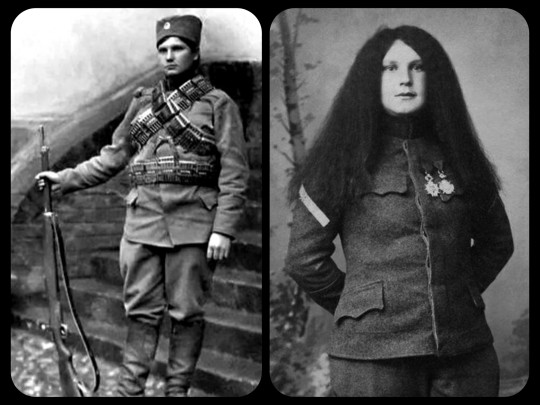
This is a total rewrite of a post that I did last year, with much more detailed information, more photos, and some additional sources.
Milunka Savić is regarded as the most decorated female combatant in history. She fought for the Serbian Army during both of the Balkan Wars, before returning to the battlefield again during WWI. Savić was wounded in battle on 9 separate occasions and survived the Serbian Great Retreat, making the perilous journey across the mountains of Montenegro and Albania through the dead of winter with a serious head injury.
Her military career began during the First Balkan War in 1912, when her younger brother was called up to serve in the Serbian army, and she decided that she would covertly take his place. She cut her hair, wore men's clothing, and presented herself as her brother.
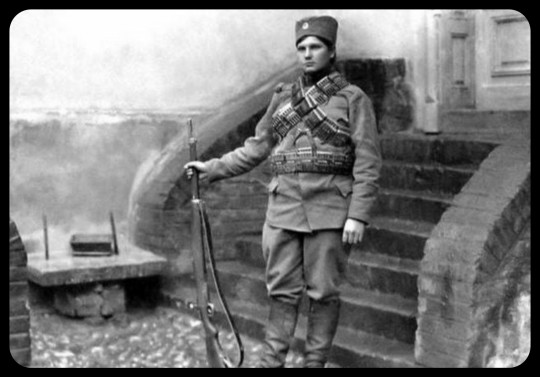
The First Balkan War, 1912: Milunka Savić as a young soldier during the First Balkan War, shortly after joining the Serbian army
She was able to hide her true identity for quite some time. Her skills as a soldier quickly became evident as the war progressed, and she earned her first medal/promotion during the Battle of Bregalnica in 1913. Unfortunately, she was hit by shrapnel from a Bulgarian grenade during her tenth deployment, causing injuries to her chest and abdomen, and those wounds (along with the subsequent medical treatment) ultimately led to the discovery that she had lied about her identity.
In recognition of her accomplishments on the battlefield, her commanding officer decided not to punish her for the initial deception, but informed her that she would not be allowed to return to combat -- as a woman, she could only be transferred to the nursing division instead.
As the story goes:
Savić was called before her commanding officer. They didn't want to punish her, because she had proven a valuable and highly competent soldier, and the military deployment that had resulted in her [sex] being revealed had been her tenth; but neither was it suitable for a young woman to serve in combat. She was offered a transfer to the Nursing division. Savić stood at attention and insisted that she only wanted to fight for her country as a combatant.
The officer said he'd think it over and give her his answer the next day. Still standing at attention, Savić responded, "I will wait." It is said he only made her stand an hour before agreeing to send her back to the infantry.
Savić was able to serve in a combat role throughout the remainder of the Balkan Wars.
The Second Balkan War finally came to an end in 1913, but that peace was short-lived, as World War I erupted just a year later. Savić returned to the military once more, serving in the elite "Iron Regiment" of the Serbian army.
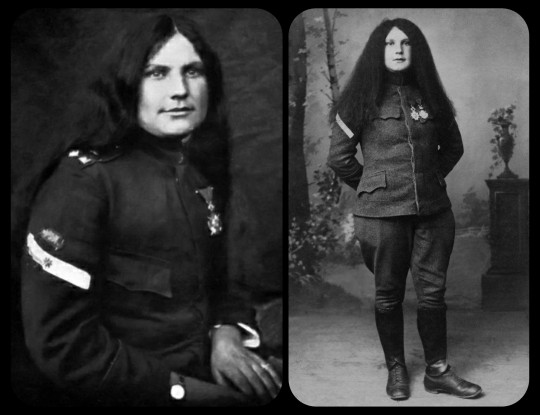
World War I, c.1915-1916: Savić was no longer forced to hide her identity when she returned to battle during WWI, and these images show her posing in uniform with her hair grown out
Savić received the Serbian Karađorđe Star with Swords medal on two separate occasions during WWI; the second medal was given to her after the Battle of Crna Bend in 1916, where she was credited with single-handedly capturing 23 Bulgarian soldiers. She received several other medals throughout the course of her career, including the French Legion of Honor (twice), the French Croix de Guerre, the Russian Cross of St. George, the British Medal of the Most Distinguished Order of St. Michael, and the Serbian Miloš Obilić.
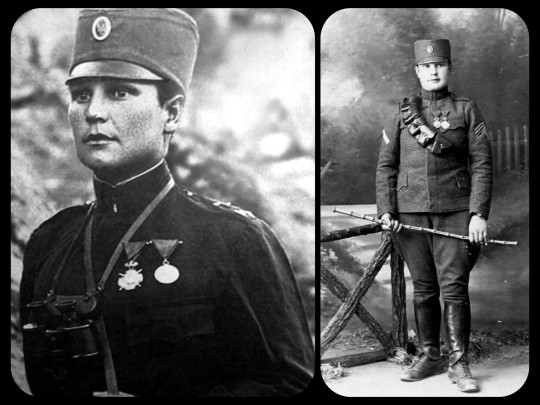
WWI, c.1915-1916: Milunka Savić as a Corporal in the Iron Regiment
She suffered a serious head injury while fighting along the Macedonian front, and she was still gravely wounded when Austro-Hungarian, German, and Bulgarian forces gained control of Serbia in the winter of 1915. The Serbian army was then ordered to make a full retreat from Serbia; Savić and her fellow soldiers, along with the Serbian government and more than 200,000 civilians, were all forced to flee through the mountains of Montenegro and Albania in the dead of winter, hoping to reach Allied forces along the Adriatic Coast -- a perilous journey that would later be known as the Serbian Great Retreat (or the Albanian Golgotha). Roughly 400,000 people embarked on this journey, and less than 180,000 of them survived, eventually reaching the Allied ships along the Adriatic coast.
Despite her injuries, Milunka Savić was among the survivors. She was sent to an infirmary, where she spent several months recovering from her injuries, before she returned to the battlefield alongside Allied forces.
At the end of the war, the French government offered to provide Savić with a full pension and living accommodations in France, in recognition of her actions while serving alongside the French military during WWI. She ultimately declined the offer and chose to retire back in Serbia instead, where she and her husband settled down to raise their daughter and three other girls that Milunka had adopted. The couple would later separate, however, and Milunka was left to raise her children as a single mother, working at a local bank to make ends meet.
In 1941, Serbia (which was then part of Yugoslavia) fell under Nazi occupation. During this period, Savić was involved in providing medical support to local partisans and anti-fascists who had resisted the Nazi occupation. She was eventually arrested by German officers; there are differing accounts of the events leading up to her arrest, with some sources suggesting that she was arrested as a result of her involvement with the local partisans and other anti-fascist elements, while other sources claim that she was arrested after she offended several Nazi officials by openly refusing to attend a formal banquet that was being held in honor of the German military campaign. In any case, she was imprisoned at the infamous Baljinca Concentration Camp for ten months before finally being released.
She faced other forms of hardship in the aftermath of WWII, as she struggled to support herself and her children. She worked several low-paying jobs over the years, while living in a dilapidated, decaying house in Belgrade. Her name (and her long list of accomplishments) had largely faded into obscurity by then.
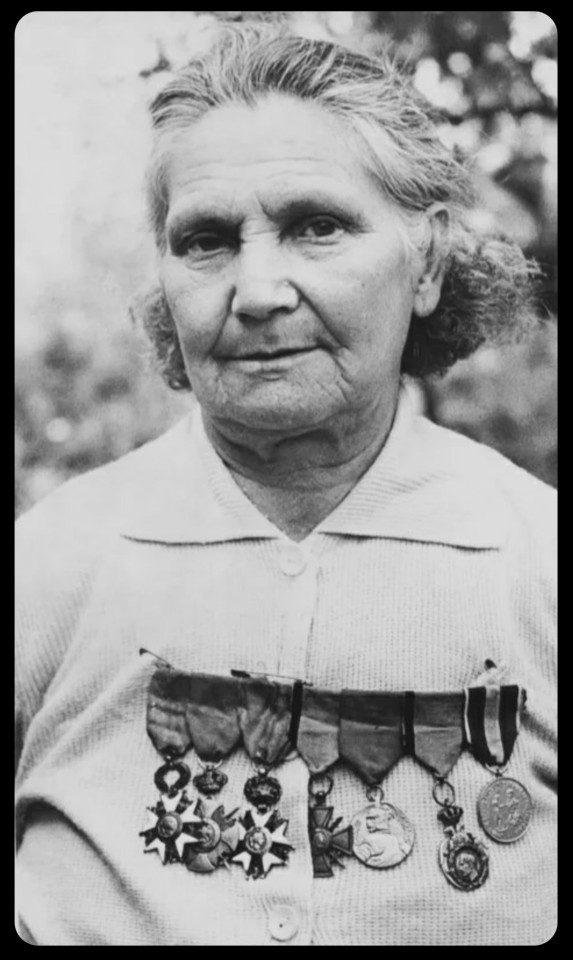
Serbia, 1972: Milunka Savić proudly displaying some of her medals in 1972, when her story became more widely known
It wasn't until the early 1970s that her involvement with the military finally began to receive more widespread attention, both in Serbia and abroad. Following the 1972 publication of an article that told her story, her local community in Belgrade quickly rallied to provide her with newer, more suitable living arrangements.
Sadly, she passed away within just a year of the article's publication.
In 2013, Milunka Savić's remains were relocated from the small mausoleum where they had been interred since 1973, and she was reburied in Belgrade's "Alley of the Greats," where some of the most well-known and most widely respected Serbians are laid to rest.
Sources & More Info:
Research Gate: Milunka Savić: the Forgotten Heroine of Serbia
Girl Museum: Milunka Savić
Law and Politics: The Position of Women in the Serbian Army
Medium: The Fearless Woman-Bomber Who Died Proud, Broke, and Forgotten
Wikipedia: Milunka Savić
Mental Floss: The Serbian "Great Retreat" Begins (WWI Centennial)
#history#Milunka Savić#women in history#serbia#women in the military#balkans#military history#wwii#wwi#yugoslavia#milunka savic#challenging gender norms#feminism#femininity#serbian history#women's liberation#women in war#real-life mulan
25 notes
·
View notes
Text
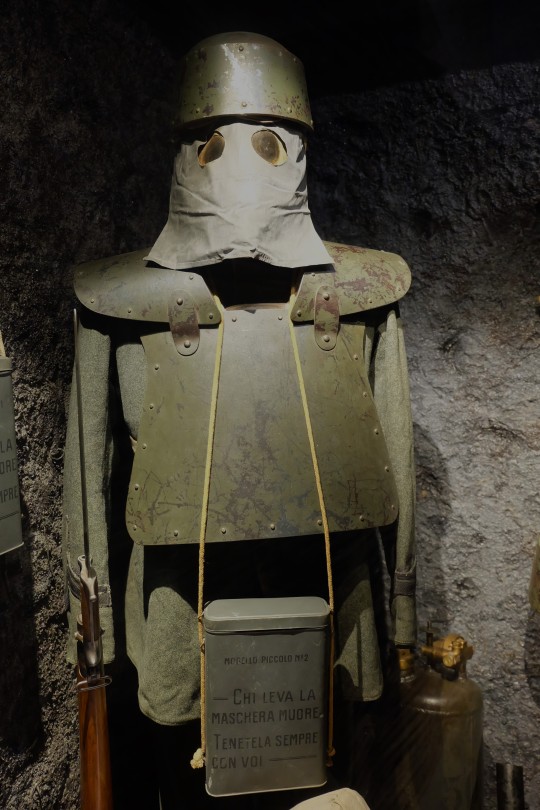
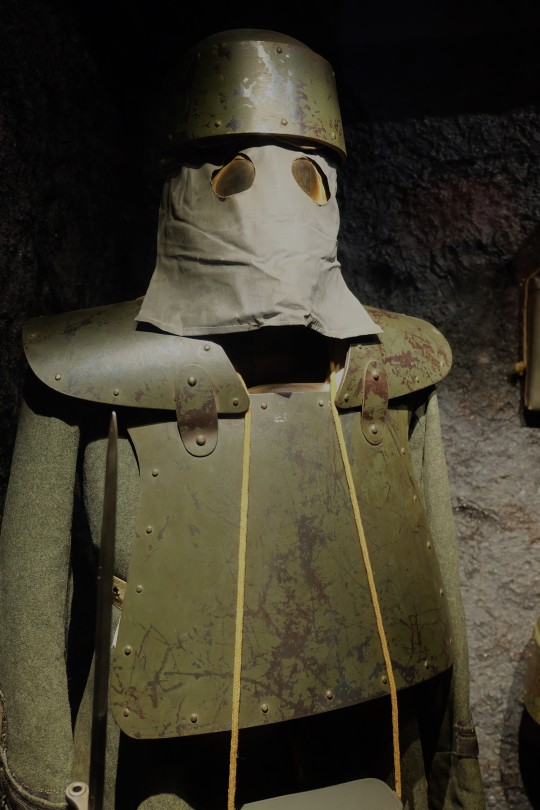
Assault Armour of 5th Engineer Regiment from the Kingdom of Italy dated around 1915 on display at the Heeresgeschichtliches Museum in Vienna, Austria
The 5th Engineer Regiment of the Royal Italian Army fought on the Italian Front against the Austro-Hungarian Empire. The Engineer regiments were responsible for maintaining the mechnised transport and supplies lines of the army as well as mining battalions. Armour for the engineers would have protected them while working but it proved to be too cumbersome and heavy for practival use.
Photographs taken by myself 2022
#armour#armor#fashion#uniform#italy#italian#kingdom of italy#20th century#first world war#military history#heeresgeschichtliches museum#vienna#barbucomedie
88 notes
·
View notes
Photo

The Great Turkish War or War of the Holy League (1683-1699) and its aftermath
« Atlas des guerres – Époque moderne », Autrement, 2023
by cartesdhistoire
In 1682, the Austro-Turkish war became inevitable: faced with collusion between Louis XIV, the Turks, and Hungarian revolts led by Thököly, an Austro-Polish alliance was formed.
150,000 Turks marched towards Hungary to besiege Vienna, reaching it on July 14. Polish leader Sobieski, arriving in September, imposed his strategy on a coalition army of 75,000 men: crossing the Danube and taking positions on the heights of Kahlenberg. The charge of Polish hussars on September 12 was thunderous, pushing all the way to the fleeing Grand Vizier's camp. Turkish losses were heavy, Vienna was liberated, Ottoman progress was disrupted, and the campaign ended with several more Polish victories.
The formation of the Holy League (with Venice in 1684 and Russia in 1686) allowed the resumption of the offensive by the imperialists: Pest was captured (October 1684), Buda as well, but with difficulty (September 1686), opening the road to Belgrade despite a Turkish counteroffensive resulting in the defeat of Mohacs (1687). Hungarian cities were conquered one by one, Transylvania came under Habsburg sovereignty, but the War of the Augsburg League diverted the imperial troops. A border was drawn on the Danube while Eugene of Savoy, fighting alongside the Imperials, won the Battle of Zenta in 1697. Peace was signed in 1699 (Treaty of Karlowitz): Hungary, Transylvania, and the Banat of Temesvar came under Habsburg domination; Podolia returned to Poland and Azov to the Russians.
The expansion of the Habsburgs continued thanks to their engagement on the side of Venice (Veneto-Ottoman war of 1714-1718). The victories of Eugene de Savoy (Petervarden in 1716, siege of Belgrade in 1717) marked the maximum expansion of the Habsburgs with the Treaty of Passarowitz in 1718 (some territories were returned after the Austro-Turkish War of 1737-1739, with the Treaty of Belgrade).
39 notes
·
View notes
Text

Yiddish writers, Warsaw, 1922
From left to right, with short biographies:
Esther (Esye) Elkin (?–?) was the wife of Mendl Elkin.
Mendl Elkin (1874–1962) was born to a family of Jewish farmers in Belarus. Though working as a dentist for six years, he was more interested in arts and culture, and would spend his spare time writing for socialist newspapers and acting in an amateur Russian-Yiddish theatre group. He spent the 1910s–1920s between Bobruisk and Siberia before moving to Vilna and founding a theatre group, as well as editing literary journals and writing poetry. He would later move to New York, where he served as Chief Librarian for YIVO.
Peretz Hirschbein (1880–1948) was born near Grodno; his father operated a water mill. He studied at a yeshiva before becoming a Hebrew teacher. In his 20s he began to write poetry and plays in both Hebrew and Yiddish, and would soon move to Odessa to stage his plays. After his theatre troupe disbanded in 1910, he spent the remainder of his life travelling, finally moving with his wife Esther Shumiatcher to Los Angeles.
Uri Zvi Grinberg (1896–1981) was a Yiddish writer before moving into Hebrew. Born into a Hasidic family in what is today Ukraine, he served in the Austro-Hungarian army. Radicalized by the November 1918 pogrom in Lwów, he spent the interwar period between Palestine and Europe. He co-founded the self-proclaimed fascist group Brit HaBirionim and later served as a Member of Knesset for Herut. He was awarded the Bialik Prize three times, as well as the Israel Prize for his contributions to literature.
Khane Kacyzne (?–?) was the wife of Alter Kacyzne. Together they had a daughter, Shulamith, who survived the Holocaust by hiding as a non-Jew. Khane was murdered at Bełżec.
Alter Kacyzne (1885–1941) was a prolific photographer and writer, born to a bricklayer and a seamstress in Vilna. He took up photography early, at age 14, by which point he had also taught himself Hebrew, Polish, German, Russian, and French (alongside his native Yiddish) and had begun to write poetry. Through the interwar period he worked as a photojournalist, travelling extensively, as well as serving as editor for several literary magazines and writing for communist newspapers. He was beaten to death by Ukrainian fascists in 1941, and his wife Khane was murdered at Bełżec extermination camp.
Esther Shumiatcher (1896–1985) was born in Grodno, though her family emigrated to Alberta, Canada in 1911. Interested in poetry and screenwriting, she worked several jobs to make money: as a waitress, in a meat-packing plant, and helping her family run a boarding house out of their home. In the 1920s she went to Warsaw and worked extensively as a poet; her poem "Albatros" gave its name to a modernist Yiddish journal. She was married to Peretz Hirschbein, whom she met while he was taken ill in Calgary and nursed back to health in her family's home. After her husband's death in 1948, she moved to New York.
From the YIVO Archives.
#yiddish#yidishkeyt#jewish#jewish history#uri zvi greenberg#uri zvi grinberg#esther shumiatcher#peretz hirschbein#perets hirshbeyn#alter kacyzne#khane kacyzne#mendl elkin#esther elkin#1922#jumblr
67 notes
·
View notes
Text
Fanfic galore
S is spotted on a boat in London by a French fan. Crazy comments ensue in Mordor:

AHAHAHAHA, out of all nations on this planet, they just had to come up with a Brazilian suspect!
And the host (that petty racist I refuse to name) immediately and somewhat gleefully gets on the choo-choo train.
The woman who posted that London pic is not Brazilian. She is desperately (and even provincially) French, but then it does not seem to suit your agenda (for what reason? I wonder 🙄) and then you just couldn't help yourself, could you?
Let's unpack. Yesterday, the X user Véesse, aka Drfolledamour, posted this innocent pic:

In the process, she gives us plenty of info on her real identity, because she is a normal human being with an average number of social media followers and being middle-aged, she does not give a crap about silly, sick hiding games on the Internet.
First, her initials, V.S (Véesse), with a rather cool & clever pun on the French word déesse/goddess. I like her and would definitely have coffee with her: my type of happy go lucky character.
Then, a very important clue, the X handle - @Drfolledamour. Anon and the vast majority of the non French or Francophile users would be excused not to know that is the French translation of one of my favorite Stanley Kubrick movies, Dr. Strangelove:

Then, the short bio, in her X profile. We are informed her grandfather was born in Lviv and her grandmother in Krakow. Lviv is in this country:
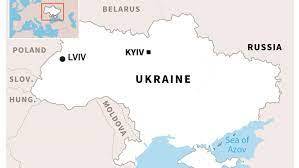
This country, if you don't mind reading, is called the Ukraine.
Krakow is to be placed here:

The country is called Poland. It is bordering Ukraine.
Until Brusilov's army got there, in 1914, Lviv was a part of the Austro-Hungarian empire and Krakow was under Russian control until 1794. Both cities featured sizeable Jewish communities, out of which a hefty chunk emigrated to the more tolerant France, especially in the Interwar period.
V.S. is a French woman proud of her Jewish roots, that's all. She also teaches economics in a French high school near Paris, in Chaville. But that's too complicated for you, I suppose.
However, her spelling sucks: 'j'ai dit que ma fille le kiffais' should be correctly written ' j'ai dit que ma fille le kiffait'. I told him my daughter liked him (a lot).
You see, 'kiffer' means 'to like/enjoy something a lot'. It comes from the Arabic Algerian colloquialism kif (كَيفْ), which means pleasure or amusement, and it went on into the French colonial slang, back in the day Algeria was a French colony. And onwards to the mild, mainstream jargon of today, keeping its meaning intact.
I am sorry, Brazilian friends. No woman of your country and few foreigners would spontaneously kif something or someone, nor make the sort of puns only a French native speaker would. Ask *urv, she just said she speaks French (proficient in buying a metro ticket using Duolinguo, I suppose).
Yes, these people are that stupid. And racist.
This is pathetic and the blogger should excuse herself, at a minimum. Which she won't. Of course.
50 notes
·
View notes